Notice of an inscription in antique characters, found on a tabular stone, or amulet, in one of the western tumuli of, probably, the beginning of the sixteenth century called the Grave Creek Mound Tablet.
The discovery of an inscription upon a tablet in a large tumulus near Wheeling, in Western Virginia, gives an importance to the opening of that mound which it would not otherwise possess. This archaeological discovery was made, as Mr. Abelard Tomlinson the proprietor states, (Vide Western Pioneer) on the sixteenth of June 1838. The country had then been settled fifty-seven years, and had been first explored two years earlier. Mr. Jesse Tomlinson, the original proprietor, and uncle of Abelard, had carefully guarded it, and prevented any excavations from being made, or any of the forest trees, with which it was covered, from being cut. He yielded, at length, to the public curiosity to explore its contents, when his nephew, Abelard Tomlinson, entered into an arrangement with some other persons to execute the work on a fixed plan of excavation. They ran a horizontal gallery into its centre, and sunk a shaft from its top to intersect this audit, as represented in Plate 12, Figure 1.
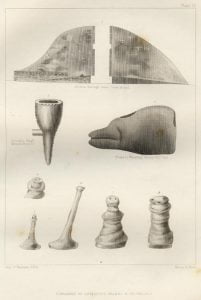
To penetrate a tumulus of earth of three hundred and thirty-three feet in circumference, and seventy feet in height, (Plate 5, Figure 2,) with an unbroken surface, bearing large trees, was not a light work, and it appears that the labor of several hands, for a number of months, was required. 1 The results, which have been recorded in the pages of the American Pioneer, Volume 2d, page 197, were the discovery of two rude tombs containing skeletons, and a number of beads, amulets, and shells; but nothing indicative of an unusual civilization in the builders of this tumulus, except the inscription stone; even if the block-prints, discoidal stones, syphons of steatite, and watch-towers, hereafter to be noticed, be thought to denote a higher state of wants than the Indian tribes had, they were not the wants of high civilization. Little or no importance appears to have been attached to the inscription for several years.
The men engaged in the work were no archaeologists. It was supposed to be in Indian characters, and they are called “hieroglyphics” by Mr. Townsend, a writer who described the opening of the mound in a letter which was published in the Cincinnati Chronicle, a weekly gazette, of February 2d, 1839. He also gave a drawing of the inscription. 2 A copy of this paper was transmitted to me by a friend. Having, at the same time, a copy of Mr. March’s Grammar of the Icelandic, of 1838, the appendix to which contains the Runic alphabet, I observed some corresponding characters. By reference to an inscription from Dr. Plott’s History of Staffordshire, it was also seen that there were several of the characters quite identical with the ancient form of the Celtic alphabet, as employed in Britain in the, so called, Stick-Book. A copy of the inscription (Townsend’s copy) was transmitted to Professor Rafn, at Copenhagen, the distinguished Secretary of the Royal Society of Northern Antiquaries. Mr. Rafn does not find it to be Runic, but is disposed to consider the inscription Celtiberic. 3
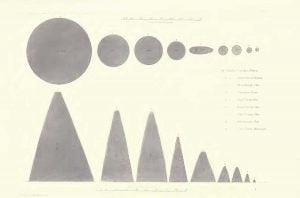
Mr. Abelard B. Tomlinson states, in a letter above referred to, that he commenced opening the mound on the 19th of March, 1838; that he wrought at the excavation himself; and that he found the first or lower vault on the 4th of April, and the second or upper vault on the 16th of June of that year. That the osseous remains of two human skeletons in a state of decay, were found in the first, one of which had six hundred and fifty beads, and a small yoke-shaped ornament or implement, with two perforations; the other was without any ornament whatever. That the upper vault contained the remains of but one skeleton, and a great number of trinkets, the chief of which were seventeen hundred bone-beads, five hundred sea-shells, one hundred and fifty pieces of mica, five copper wrist and arm bands, and a small flat stone, of which he furnishes a facsimile, page 195, about three eighths of an inch thick, with an engraving.
Dr. Samuel George Morton, in his Crania Americana, page 201, publishes extracts of a letter from Dr. James W. Clemens of Wheeling, of the general date of 1838, in which he describes the opening of the mound, and the various objects discovered, without mentioning the inscribed stone, unless it be included in the general term, “together with various articles of minor interest, page 222, Crania Americana. It is to be regretted as an historical question, that the precise date of this letter is not given. But little interest appears to have been excited by the “stone,” and nobody, if we refer to the first accounts, appears to have regarded it as containing alphabetical characters.
Mr. Clemens falls into the popular error of considering the beads as “ivory.” They have been found to be formed of seashells, 4 and agree in their shape with the ancient wampum as disclosed in Western New York and at Beverly in Canada. He also states the cortical layers of the large oak, which stood at the top of the central part of the mound, at three hundred: they are stated by Mr. Tomlinson at about five hundred. 5 This appears to be a point of some importance, as by the latter statement, we have the date of A. D. 1338, as the era of the abandonment of the mound, and by the former, A. D. 1538, or forty-six years after the discovery of the country by Columbus.
De Leon discovered Florida in 1512. From the collection of Terneau Campans, the mouth of the Mississippi appears to have been discovered in 1527. There would be no inconsistency in supposing that some of the followers of De Soto had carried a Celtiberic inscription into the valley of the Ohio.

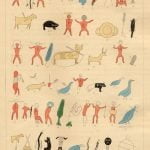
Dr. Morton (Crania Am., Plate 53) gives a figure of the cranium found in the upper vault, from a drawing by Mr. Clemens, and states its facial angle at 78. This cranium has been recently drawn by Capt. S. Eastman, U. S. A., from the original in the possession of Dr. De Hass of Virginia, (See Plate 38, Figure 6.) Its posterior developments appear to be large, and assimilate it to the Southern type of crania.
M. Jomard, of Paris 6 , is inclined to deem it an inscription in the ancient Libyan language. He had before him, however, but an imperfect copy of the inscription, which was transmitted in 1839, by Mr. Eugene Vail; being the copy originally published in the Cincinnati paper by Mr. Townsend, which had misled others.
Dr. Wills De Hass, of Grave Creek, has recently (1850) brought to Washington the original stone, a facsimile of which is given by Capt. S. Eastman, U. S. A. (Plate 38, Figure 1.) He has also copied its reverse, (Figure 2.) These drawings accurately correspond with the copy published by the American Ethnological Society in 1846. The same artist has also copied the ancient Celtic inscription before referred to, (Plate 38, Figure 3); also a curious device, found in one of the minor mounds at Grave Creek Flats (Figure 4); and a circular stone, without inscription, but identical in material with the inscription stone, (Figure 5.) These facts will enable the reader to form his own judgment in the matter.
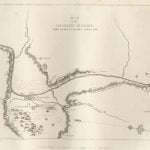
Grave Creek Flats appears to have been the site of an ancient Indian town of importance. Seven mounds, or their remains, still existed upon these flats in 1844, although the plow and the spade had done much to obliterate the smaller ones. There were also traces of a large circular work, embracing a part of the public road leading northeast to the hills. The relation of these several objects is shown by Plate 39. After crossing this low ground, there were also traces of a circumvallation on the more elevated level grounds; and on rising the hills to Parr’s Point, there was still, quite entire and undisturbed, the ruins of a tower or look-out, upon a commanding point of ground on the farm of Mr. Mitcheltree. (See Plate 39.)
This work had been commenced by excavating the earth several feet, and walling it up with rough stones, in the manner of a well. From the quantity of fallen stones around and within this excavation, this tower must have been many feet above the ground. Every one of the stones of which it is composed, must have been carried up the acclivity for nearly a mile; as the surface of the hills consists entirely of loam and loose soil.
A corresponding work of a similar character appears to have existed on the apex of the hill which forms the opposite banks of the Ohio River, in Belmont County; and a defensive work of some extent exists on the high grounds back of this apex, but separated from it by a deep ravine. (See Plate 39.)
To enable the reader to appreciate the relative position of the great mound, and the other objects of antiquarian interest in its neighborhood, a plat of the entire “flats” is introduced. (Plate 39.) There is also added, a view of the Ohio River, taken from the rude observatory which has been constructed at the top of the great mound looking to and across the Ohio, into Belmont County. (Plate 75.)

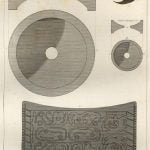
Plate 29, Figures 1, 2, 3, 4, represent a stone block-print and its reverse, found in one of the minor mounds in the town of Elizabethtown, on the superior plateau of the Grave Creek Flats. This antique object is analogous to a print of the same character, found in a mound in Cincinnati. (Plate 23, Fig. 5.)
Figures 5, and 6, Plate 29, denote porphyry axes; perhaps another form of the fleshing instrument, disclosed by the minor mounds of the Grave Creek Group.
With regard to the inscription, it may be said, if genuine, to be intrusive, and of foreign origin. It has belonged to some adventurer, or captive carried by the tribes to this spot. Many contend, on what are considered slight grounds, for a comparatively high state of civilization in the ancient inhabitants of the West, and adduce their architectural ruins, and attainments in fortification, as a proof of it. But, granting whatever can be advanced on this head, it would contradict all our actual knowledge on this branch of American archaeology, to admit the possession, by them, at any period known to us, of an alphabet of any kind. The characters employed in picture writing by the Toltecs and Aztecs, were symbolic and representative, and they have left irrefutable evidences of their high proficiency in them: but nothing more. There can be no pretense that any Indian race who ever inhabited this valley possessed an alphabetic art. The inscription of this tumulus, if it be true, is foreign. The question of its genuineness must rest on the veracity of Mr. Tomlinson, and his neighbors who have united in his statements. On the score of it’s being of Iberic origin, the account of Dr. Clemens, who is the least favorable to the antiquity of the mound, opposes no bar to a foreign theory. Giving, as his facts do, the date of 1538 puts it twenty-six years after the discovery of Florida by De Leon, and one year subsequent to the discovery of the mouth of the Mississippi by Narvaez. A stronger objection is found in the inability of the Copenhagen antiquarians to read it, while acknowledging a large portion of its character to be in the Spanish type of the Celtic. The following characters are common, it will be seen, to the inscription at Dighton Rock and Grave Creek Mound, namely:

A still greater amount of resemblance to it appears in the “stick-book” character of the ancient British Celtic. This is perceived in the characters

which are common to both inscriptions, namely, the Celtic and the Virginie. There would appear to be some grounds here for the Welsh tradition of Madoe.
We have thus three inscriptions, which appear to have been made in the same mixed character, or to have something in common. Elements of an alphabet are seen which were known to many nations of Western Europe, and were originally derivative from the banks of the Mediterranean, before the introduction of the Roman alphabet.
Devices on an Antique Globular Stone, Found in the Ohio Valley
Every fact relating to asserted inscriptions of ancient date, on this continent, requires the closest scrutiny. But we are not at liberty to deny record to any well-attested report. There was found in one of the group of minor mounds of the Grave Creek Flats, in the Ohio Valley, a small globular stone, about one inch and a half in diameter, containing some devices, which resemble those of the inscribed stone alleged to have been found by Mr. Tomlinson in the large mound at that place. A cast of this stone was presented to me in 1844, during a visit to that place, by Dr. Wills De Hass, of which a copy, with its inscriptive matter, is given in Plate 38, Figure 4. The characters on this stone appear to be as follows:

There is some eccentricity in the forms of the letters. Some are recognized on the Dighton Rock.
Nothing is more demonstrable than that whatever has emanated in the graphic or inscriptive art of petroglyphs, on this continent, from the Red race, does not aspire above the simple art of pictography; and that wherever an alphabet of any kind is veritably discovered, it must have had a foreign origin. By granting belief to any thing contravening this state of art, we at first deceive ourselves, and then lend our influence to diffuse error.
Citations:
- We understand that the estate of Mr. Jesse Tomlinson was charged with $2,500 for this work.[
]
- This was subsequently found to have been copied with some material inaccuracies.[
]
- Memoires de la Societé Royale des Antiquaries du Nwd, 18401843, p. 125.[
]
- See Transactions of the American Ethnological Society, Vol. I.[
]
- Am. Pioneer, page 199.[
]
- vide Seconde Note sur une Pierre Gravée trouve dans un ancien tumulus Americain.[
]
